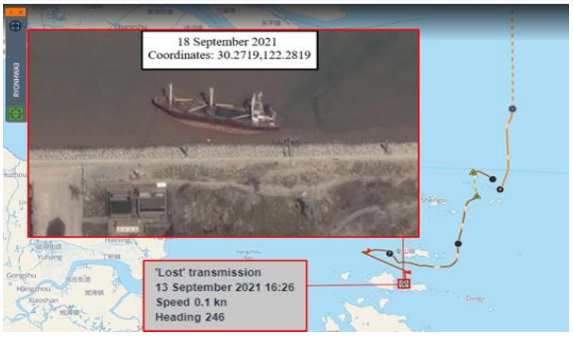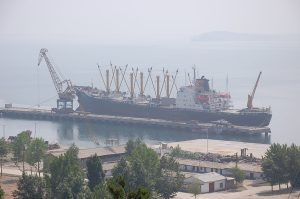An unusual admission from North Korea’s Maritime Administration confirms extensive quarantines outside the country’s largest port at Nampho (also spelled Nampo) last year, as the country grappled with its response to cases of COVID-19 within its borders.
At various points throughout pandemic, satellite imagery indicated that vessels visiting North Korea were being made to wait outside the country’s West Sea Barrage, an 8-kilometer system of dams that restrict access to the North’s Taedong River and port infrastructure, though only cargo quarantines within the port itself were reported by the North’s official media outlets.
But an accident report issued by the North Korean government provides details on these measures, and the lengthy repatriation process of a group of 25 coal smugglers whose ship was wrecked in China’s Zhoushan area in September 2021, but did not make it back to North Korea until August the following year.
The Dangers of Smuggling
Being a sailor in North Korea’s creaking merchant fleet is a hazardous occupation at the best of times, and North Korean vessels have always ranked among the least safe in the world. But the dangers no doubt multiply when the ships are involved in sanctions breaking activity. In such cases the North’s ships attempt to hide their locations by switching off tracking equipment and obfuscating their names and ID numbers to make identification difficult.
A report last year from the Asia Maritime Transparency Initiative at the Center for Strategic and International Studies in Washington detailed the last journey of the Ryong Hwa 3, a U.S.-designated coal smuggler that ran aground in China’s Zhoushan port area, a favored hot spot for North Korean coal smuggling and sanctions evasion.
The report noted how such an incident would likely put China in a difficult position. North Korea cannot transfer its vessels to foreign-owned companies – not to mention the difficulties that come with attempting to buy or sell a U.S. designated asset – yet satellite imagery showed the vessel being scrapped, presumably by Chinese entities.
How can a company scrap a vessel they do not own? Perhaps in the case of legitimate salvage, if the ship had suffered an accident and been abandoned. Yet accidents require the use of local infrastructure. Sailors must be rescued, reports must be made, and eight months on from the wreck there was no word, either official or in the media, on the Ryon Hwa 3.
But after the wreckage of the Ryon Hwa 3 appeared in the U.N. Panel of Experts on North Korea’s yearly report in early 2022, North Korea’s Maritime Administration issued its first ever publicly available report to the International Maritime Organization (IMO) regarding a North Korean vessel accident, despite there being many other cases involving North Korean ships listed in the IMO’s database.

A graphic from the U.N. Panel of Experts’ 2022 report, showing satellite imagery of the grounded Ryon Hwa 3 and a map of its travels.
A Long Road Home
While the report is deafeningly silent on the nature of the ship’s cargo, or what exactly the U.S.-designated vessel was doing in Chinese waters, it does provide interesting details into how North Korea runs its merchant fleet. The official document notes that steadily worsening weather developed into a typhoon and ran the Ryon Hwa 3 into its final resting place on the shores of a Chinese island.
Yet despite the difficult conditions, the North Korean government publicly threw its captain under the bus. “The cause of the stranding of Ryonhwa 3 was the failure of the master to make a proper decision in selecting a shelter and when the anchor was dragged, in responding against the emergency,” the report noted without hesitation.
It appears that being a North Korean captain – which in this case apparently meant sailing a 40-year-old, U.S.-designated vessel under instruction to switch off safety equipment and conduct prohibited coal transfers in a bid to keep illicit revenues flowing – is a thankless task.
Yet the report also provided a few details on the 25 sailors’ 11-month voyage back to North Korea, during which they apparently had to endure two separate quarantine procedures.
According to North Korea’s Maritime Administration, the accident took place on September 13. The sailors were quarantined in China until October 5. Their status in China remains unknown from that point until they were sent back to North Korea six months later. And their journey did not end there.
“In the middle of April, the crew returned home by a ship of the company and completed the quarantine and medical isolation period in waters off Nampho port by August,” the report noted. That revelation potentially sheds light on various changes in how North Korea handled inbound maritime traffic during the pandemic years.
Satellite imagery and vessel tracking data of North Korea’s Nampho port sometimes showed long queues outside the West Sea Barrage. Other images showed how North Korea had set up quarantine zones at import facilities, while the World Health Organization reported that vaccines and medical equipment were held up in Nampho. But the accident report is the first time that Pyongyang has released specific information about the restrictions that it imposed on returning sailors and vessels.
No doubt these strict measures also affected the North’s sanctions evasion programs. Prior to the pandemic, the U.N. Panel of Experts noted that Pyongyang was using unregistered barges to smuggle coal and other items in breach of U.N. resolutions. The unregistered barges were an effective evasion tool as they were difficult to identify and trace. Despite that, they completely disappeared from Pyongyang’s evasion playbook during the COVID-19 years, and have yet to make a return.
Notably, they were also designed for use on rivers and coastal waterways and lacked many of the features of their ocean-going counterparts – the type of features that would allow them to endure a five-month quarantine outside North Korea’s West Sea Barrage, like the one faced by the crew of Ryon Hwa 3.
It seems probable that the sailors’ problems may have been compounded by their return also coinciding with many cases of what North Korean media called “fever” spreading throughout the country, when Pyongyang also reportedly implemented stronger lockdowns and additional COVID-19 measures. These restrictions were in place until around August, which may help explain why the Ryon Hwa 3’s hapless crew had to wait outside the country’s borders for so long.
But their lengthy quarantine also highlights the ongoing differences between North Korea and the rest of the world. While many other countries during the pandemic strove to get their nationals abroad home on specially organized humanitarian flights, Pyongyang took the opposite tack, keeping sailors who may have been exposed on a rusting ship, floating outside a fortified wall for half a year.































